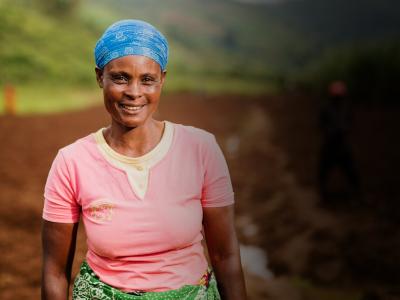Women for Women International’s former President and CEO Afshan Khan shares her experiences visiting our programs in Kabul and Istalif, Afghanistan in July 2012
In the past few days I have had the opportunity to travel to Afghanistan and see first-hand the impact of the work of Women for Women International. In a country that has recently been in the press for the brutal treatment of women, including the public execution of a young woman by the Taliban for alleged adultery, I witnessed the diversity of opportunities for women.
As I met and spoke with women there, I was reminded that even in the harsh reality of a country where 90% of rural women are illiterate and maternal mortality is one of the highest in the world at 460 deaths per 100,000 live births (compared to 21 per 100,000 live births in the US). All the women had dreams of a better future for themselves and their daughters. Against all the odds, they had sought change and created opportunity, so that as women they could define their destiny.
I found none of the passivity nor victimization that is so readily portrayed in the press – what I found were determined women, who broke barriers to enroll in Women for Women International’s program earn to sustain an income, improve health and wellness, engage in family and community decision-making, and participate in social networks and safety nets.
They continued to challenge the boundaries around them by opening their own business, forming networks or associations, and daring to dream of a future where they can readily earn an income, contribute to their families’ needs, send their sons and daughters to school, and act as agents of change in their own communities.
This was the story of Zergona Sherzad who was producing clothing and employed more than 80 women. It was the story of Raisa Jahn and Mehbooba Jahn who welcomed us to their modest home in Kabul where in the front room they had set up a very small beauty to cut hair, shape brows, and provide make-up to brides. They proudly showed us their products, and I watched as they carefully plucked the brows of their client.
Nowhere was this determination more apparent than in Istalif. There I met a young woman, Shazia, who had walked two hours from her neighboring village to try and enroll in our training program that will start in September 2013. I cannot get the image of Shazia out of my mind, a young woman in her early twenties who no doubt had to seek the permission of her husband, her brother or her father to make the long trek from her village. Her piercing eyes showed her determination, as she told us she had walked for two hours to get to the enrollment session. With her blue burqa tossed over her head and her headscarf casually draped over her curls, she was adamant in her commitment to attend the yearlong training sessions. She spoke of her burning desire to learn a craft that would give her the dignity of being a contributor to the household income, and allow her the opportunities to share her dreams, her hopes, and her fears beyond the confines of her home with other women whose imaginations went far beyond the four walls of their mud homes.
I listened to women as they identified barriers to building on the assets and skills they already possessed. In Afghanistan, while women are often buyers in markets, they are traditionally not allowed to sell their goods. Men are the sellers in the markets. These women wanted help in setting up a local market for women, and they wanted to learn the business skills necessary to determine the costs of producing their goods and the market price at which they could be sold. A few of them had sewing machines. but needed additional training so that their products would be of good enough quality to sell. Many of them had chickens and eggs but wondered what was a safe way for them to sell their produce, and how could they access the market? I listened and learned of the profound importance of adapting Women for Women International’s income generation programs to the cultural realities of each community we work in.
Several hundred women squeezed into the women’s community council in Istalif, a small building with wooden beams and concrete walls that had been built with support from a woman in Virginia. This small building allows women a place to meet and gives the Women for Women International enrollment team an opportunity to interview and screen potential candidates for our yearlong program.
In the room, three women carefully screened and interviewed each of the potential candidates. One of the head trainers tried to keep some semblance of schedule and order, as hundreds of women jostled and pushed to be first in line and enter the room. It was a brutal reminder of how committed these women are to redefining their lives. Women for Women International in Afghanistan could make it possible for 245 women in this group to have that opportunity starting in September 2013. Others who squeezed into the room were put on a waiting list, and some may have to wait another year before they can join. The resources are not available to accept them all. Women for Women International expects to enroll more than 4,750 women in Afghanistan in our yearlong training program in 2012. What this day made clear to me was that if Afghanistan could seize the potential of its women, they would surely change the image and the destiny of their country.
Learn more about how you can become involved in Women for Women International’s work in Afghanistan.
